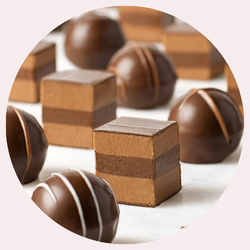Gelt
Gelt, the Yiddish word for "money," has a fascinating history tied to Jewish tradition, particularly in its association with the holiday of Hanukkah (also spelled Chanukah). Over the centuries, gelt has evolved from a practical currency to a symbolic gift, often taking the form of chocolate coins.
Chocolate Gelt
Chocolate Gelt is a sweet and festive tradition during Hanukkah, enjoyed by children and adults alike. These foil-wrapped chocolate coins have become a beloved symbol of the holiday, adding fun and flavor to family celebrations. Here’s a closer look at chocolate gelt, its origins, and how it’s used today.
History of Chocolate Gelt
- European origins: The idea of chocolate coins likely originated in Europe, where chocolate was often molded into various shapes for special occasions. The tradition of giving money during Jewish holidays predates Hanukkah. It was customary for Jews to give "tzedakah" (charity) on holidays as an expression of gratitude and generosity.
- Hanukkah: In the 20th century, chocolate makers began producing foil-wrapped chocolate coins specifically for Hanukkah, inspired by the tradition of giving real coins (gelt) during the holiday. Hanukkah commemorates the victory of the Maccabees over the Seleucid Empire and the miracle of the Temple oil lasting eight days. While the holiday doesn't mandate gift-giving, the custom of gelt emerged as a way to celebrate and support Jewish education.
- Brought to the U.S.: In the 20th century, chocolate gelt gained widespread popularity in America, thanks to Jewish immigrant communities and the commercial availability of these treats. Chocolate Gelt is usually wrapped in gold or silver foil with designs such as menorahs, Stars of David, or Hebrew inscriptions.
Hanukkah Gelt
Today, gelt continues to play a role in the Hanukkah celebrations of many Jewsih families. The traditions involving gelt are often focused on joy and teaching meaningful lessons tied to the holiday.
Dreidel
Families use gelt as currency for the traditional dreidel game. Each player antes up some gelt, and the game is played by spinning the dreidel to win or lose pieces based on the Hebrew letters it lands on. Here are some examples of the letters and what happens when you land on each letter.
- Nun - Do nothing
- Gimel - Take all the gelt
- Hey - Take half the pot
- Shin - Add one to the pot
Hiding or Hunting for Gelt
Similar to hiding presents, some families hide chocolate gelt around the house, and children search for it. This adds an interactive and playful element to the holiday. Some families include riddles or clues to make this treasure hunt more exciting.
Giving Gelt as Gifts
Parents often give children chocolate gelt or small amounts of real money during Hanukkah. This serves as a token of celebration and joy. In some families, gelt is tied to lessons about financial responsibility. Children might use it to buy something special, save it, or donate to a charity.
Storytelling with Gelt
Sharing Hanukkah History**: Parents or grandparents use the gifting of gelt as an opportunity to tell stories about the origins of Hanukkah, the Maccabees, or how the tradition of gelt began.
Gelt Decorations
Chocolate gelt is often scattered across holiday tables or placed alongside menorahs as decorative accents or included in centerpieces with dreidels and candles.
Li-Lac Chocolates Gelt
One of our most popular holiday chocolates, at Li-Lac Chocolates we make gelt and all our chocolates by hand in small batches. Founded in 1923, Li-Lac is a New York favorite. Unlike other modern chocolate companies that rely on trendy ingredients and mass production, we remain true to our history and traditions. Deemed “stubbornly old fashioned” by the Wall Street Journal, we are committed to helping you keep your family traditions alive.
SHOP GELT | SHOP HANUKKAH GIFTS

